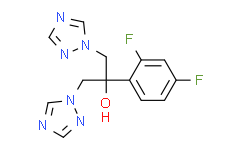| 中文别名 |
氟康唑;2-(2,4-二氟苯基)-1,3-双(1H-1,2,4-三唑-1-基)-2-丙醇;大扶康;麦道氟康;Α-(2,4-二氟苯基)-Α-(1H-1,2,4-三唑-1-基甲基)-1H-1,2,4-三唑-1-基乙醇;2-(2,4-二氟苯基)-1,3-双(1H-1,2,4-三氮唑-1-基)-2-丙醇;Fluconazole 氟康唑;zzstandard 品牌 氟康唑对照品;博柔霉素;氟康唑 EP标准品;氟康唑 Fluconazole;氟康唑 USP31;氟康唑 USP标准品;氟康唑 标准品;氟康唑的用途以及物理性状;氟康唑峰鉴别 EP标准品;氟康唑工厂;氟康唑杂质;氟康唑杂质对照品;氟康唑中间体;格列本脲;抗真菌药 氟康唑;赛庚啶;盐酸环苯扎林;Α-(2,4-二氟苯基)-Α-(1H-1,2,4-三唑-1-基甲基)-1H-1,2,4-三;氟康唑,大扶康,麦道氟康;福司氟康唑杂质A;福司氟康唑杂质1;氟康唑,医药级,纯度:>99%;高纯度,氟康唑原粉,可小包装零售
|
| 英文别名 |
Fluconazole;a.-(2,4-Difluorophenyl)-a-(1H-1,2,4,-triazol-1-ylmethyl)-1H-1,2 ,4-triazole-1-ethanol;2-(2,4-difluorophenyl)-1,3-di(1H-1,2,4-triazol-1-yl)propan-2-ol;Fluconazole solution;FLUCONAZOLE(RG);UK-49858;2,4-Difluoro-alpha,alpha-1-bis(1H-1,2,4-triazol-1-ylmethyl)benzylalcohol;diflucan;Difluean;Elazor;Fluconal;FluMycon;Flunazol;Flusol;triflucan;UK 49858;Zoltec;Fosfluconazole Impurity 1;2-(2,4-Difluorophenyl)-1,3-bis(1H-1,2,4-triazol-1-yl)propan-2-ol;alpha-(2,4-Difluorophenyl)-alpha-(1H-1,2,4-triazol-1-ylmethyl)-1H-1,2,4-triazole-1-ethanol;2,4-Difluoro-alpha,alpha1-bis(1H-1,2,4-triazol-1-ylmethyl)benzyl alcohol;[
""
];Biozolene;Biocanol;Fluconazol;Fungata;Fluconazolum;Pritenzol;Flucazol;Flunizol;Flukezol;Flucostat;Zonal;Alflucoz;Oxifugol;Forcan;Cryptal;Syscan;Canzol;Dimycon;Zemyc;Baten;Mutum;Fluconazolum [Latin];Fluconazol [Spanish];2-(2,4-difluorophenyl)-1,3-bis(1,2,4-triazol-1
|



 扫码关注公众号
扫码关注公众号